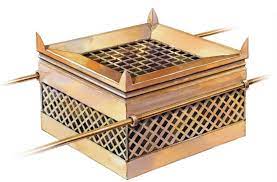Background of the Torah and the Outdated Sacrifices
No Jew could see God and live: In the Jewish mind, it had always been dangerous to approach YHVH. But you can’t see My face, because no one may see Me and live (Exodus 33:20 GWT). On Yom Kippur (the great Day of Atonement), which occurred only once a year, the High Priest could enter the Most Holy Place in the Tabernacle or Temple. There, above the ark of the Covenant (see the commentary on Exodus, to see link click Fr – The Ark of the Covenant in the Most Holy Place: Christ at the Throne of Grace) and on the mercy seat (see the commentary on Exodus Fs – The Mercy Seat in the Most Holy Place: Christ at the Throne of Grace), YHVH met mankind. As the high priest sprinkled the blood of a male goat (the azael) onto the mercy seat, the Sh’khinah Glory, the visual manifestation of God’s presence, filled up the Most Holy Place. That was as close as they could get.
Since there was naturally no personal nearness to God, there had to be some basis for communication between ADONAI and Isra’el. So the LORD established a covenant. In this covenant God, in His grace, offered Isra’el a special relationship with Himself. In a unique way He would be their God and they would be His people to reach the world (Exodus 6:7). They would have special access to Him if they obeyed His 365 prohibitions and 248 commandments. To break any one of these was a sin, and sin interrupted their access to Him. Because they were constantly sinning, their access to God was constantly being interrupted.

The outdated sacrifices: So ADONAI instituted a sacrificial system to allow a repentant Jew to atone for his or her sin. But the righteous of the TaNaKh were brought to Abraham’s side (see the commentary on The Life of Christ Hx – The Parable of the Rich Man and Lazarus) on the basis of faith. Salvation, whether in the Dispensation of the Torah or in the Dispensation of Grace has always been by faith. When that Jew brought an offering to the priest at the Temple, the fact that there was a piece of meat burning on the bronze altar (see the commentary on Exodus Fa – Build an Altar of Acacia Wood Overlaid with Bronze) did not please God in and of itself. It was the attitude of faith by the one bringing the sacrifice that was pleasing to YHVH. It was that kind of an offering that brought forgiveness of sin. Sacrifices brought in the wrong attitude, just going through the motions, were of no avail. Ha’Shem was very clear about this, both in the days of Isaiah (see the commentary on Isaiah Aj – Stop Bringing Meaningless Offerings) and in the days of Jeremiah (see the commentary on Jeremiah Cc – False Religion is Worthless).
Through the Levitical priesthood, the sacrifices of the Jewish people were made to symbolize atonement for sin. And if they were brought in faith, the barrier between them and God was taken down and they would have access to Him. It worked something like this: YHVH gave His covenant, which included 365 prohibitions and 248 commandments, and thereby offered the people access to Him. However, mankind sinned, His prohibitions or commandments were broken and the barrier went up again. Then another repentant act of sacrifice was made so that the barrier would be dropped and the relationship reestablished.
The problem was that every time the Israelite felt the weight of his or her sin, another offering of some sort had to be made (see the commentary on Exodus Fb – The Five Offerings of the Tabernacle: Christ, Our Sacrificial Offering). Their sin was only covered up until they sinned again. Atonement for their sin was never removed forever. As a consequence, the sacrifices continued hour after hour, day after day, year after year. They never stopped. Besides this, the Levitical priests themselves were sinners. They had to make sacrifices for their own sins before they could make sacrifices for the sins of the people. And so the barrier went up and down, up and down, up and down. This in itself proved to be an ineffective system. It was a losing battle against sin and the barrier it erects.
What was needed was a Perfect Priest and a Perfect Sacrifice to open the way to God once and for all – a sacrifice that didn’t deal with just one sin at a time, over and over again, but a one-time sacrifice that took all sin away forever. That, says the writer of Hebrews, is exactly what Yeshua was and what He did.6



Leave A Comment